| Ballona Creek Río de La Ballona | |
|---|---|
 Ballona Creek at sunrise | |
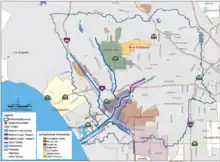 Ballona watershed | |
| Location | |
| Country | United States |
| State | California |
| Region | Los Angeles County |
| Cities | Los Angeles, Culver City |
| Physical characteristics | |
| Source | |
| • location | Los Angeles, California |
| • coordinates | 34°02′39″N 118°21′12″W / 34.04417°N 118.35333°W[1] |
| • elevation | 110 ft (34 m) |
| Mouth | |
• location | Playa del Rey - Venice, Los Angeles |
• coordinates | 33°57′37″N 118°27′33″W / 33.96028°N 118.45917°W[1] |
• elevation | 0 ft (0 m)[1] |
| Basin features | |
| Tributaries | |
| • left | Centinela Creek (south) |
| • right | Sepulveda Creek (north) |
Ballona Creek (pronunciation: "Bah-yo-nuh"[2] or "Buy-yo-nah"[3]) is an 8.5-mile (13.7 km)[1] channelized stream in southwestern Los Angeles County, California, United States, that was once a "year-round river lined with sycamores and willows".[4] The urban watercourse begins in the Mid-City neighborhood of Los Angeles, flows through Culver City and Del Rey, and passes the Ballona Wetlands Ecological Preserve, the sailboat harbor Marina del Rey, and the small beachside community of Playa del Rey before draining into Santa Monica Bay.[5] The Ballona Creek drainage basin carries water from the Santa Monica Mountains on the north, from the Baldwin Hills to the south, and as far as the Harbor Freeway (I-110) to the east.
Before colonization, the Tongva village of Guashna located at the mouth of the creek.[6][7] Ballona Creek and neighboring Ballona Wetlands remain a prime bird-watching spot for waterfowl, shorebirds, warblers, and birds of prey. In 1982, film critic Richard von Busack, a native of Culver City, described the channelized creek as "a cement drainage ditch indistinguishable in size and content from the Love Canal."[8]
Watershed and course
The Ballona Creek watershed totals about 130 square miles (340 square kilometers). Before most of Los Angeles' watercourses were buried underground, Ballona Creek drained the whole of the west Los Angeles region and fed directly from a chain of ciénegas and lakes that stretched from the Hollywood Hills to the Baldwin Hills.[4]
The major tributaries to the Ballona Creek and estuary include Centinela Creek channel, Sepulveda Creek channel and Benedict Canyon channel; most of the creek's natural minor tributaries have been destroyed by development or paved over and flow into Ballona Creek as a network of underground storm drains.
Ballona Creek watershed climate can be characterized as Mediterranean with average annual rainfall of about 409 millimeters (16 inches).[9] Land use in the watershed consists of 64 percent residential, 17 percent open space, eight percent commercial, and four percent industrial.[5] The flow rate in the creek varies considerably, from a trickle flow of about 14 cubic feet (0.40 cubic metres) per second during dry weather to 71,400 cu ft (2,020 m3) per second (see cubic meters per second) during a 50-year storm event.[5] Note: In Los Angeles County, the "water year" is measured beginning October 1 continuing until the next September 30, rather than by calendar year.[10]
Natural channels remain at some of the headwaters of Ballona Creek tributaries, while the lower portion of the stream is encased in concrete channels "either rectangular" in the east or "trapezoidal" toward the west; to the west of Centinela Avenue the bottom of the creek is unpaved and subject to tidal influence.[9][11]
Tributaries
Major tributaries of Ballona include:
- Sepulveda Creek
- Sawtelle Channel
- Sepulveda Channel
- Centinela Creek
- Benedict Canyon Creek
- Adams Channel
Many of these run wholly or partially underground in storm drains that empty into the creek.
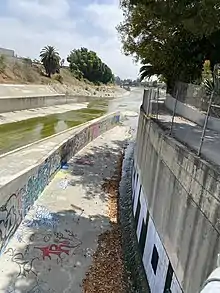
Additional watershed elements
According to a report from the Los Angeles Department of Water and Power, other contributing elements of the contemporary watershed, besides the major tributaries, are Baldwin Hills Park, Del Rey Lagoon Park, Ballona Lagoon Marine Preserve, Grand Canal, the Venice Canals, Ballona Northeast (Area C—State lands), Bluff Creek and Ballona Wetlands, Marina del Rey (including Marina Del Rey Wetland Park), Oxford Flood Control Basin, and another 15 or so minor tributaries in the Santa Monica Mountains.[12]
Ballona Wetlands, Del Rey Lagoon, Ballona Lagoon and Oxford Basin are connected to the Ballona estuary through tide gates.
The Ballona watershed is estimated to have roughly 35 percent impervious surface, which affects rainwater infiltration and groundwater recharge.[9]
There were at least 41 natural springs mapped in the Río de La Ballona watershed before development.[9] A waterway called Walnut Creek once arose near what is now the L.A. Coliseum at Exposition but it was destroyed by the 1930s flood-control engineering.[13]
A 2011 study determined that as little as two percent of Ballona's water may now come from underground springs, meaning that 98 percent of the creek's flow consists of various forms of runoff throughout the watershed.[9]
Crossings
From northern source to southern mouth (year built in parentheses):[14]
- Begins at South Cochran Avenue
- South Burnside Avenue (1974)
- Hauser Boulevard (1974)
- Thurman Avenue (1974)
- South Fairfax Avenue (1962)
- Interstate 10 (1964)
- La Cienega Boulevard (1937)[15]
- Washington Boulevard (1938)[15]
- National Boulevard north (1967), Bike Path Bridge for Expo Bike Path since 2009[16]
- Metro E Line (2012) originally Santa Monica Air Line streetcar (1909)
- National Boulevard south (1967, replaced 2009[16])
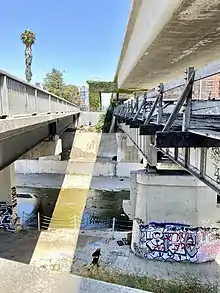
- Higuera Street (1938,[15] replaced 2023)[17][18]
- Duquesne Avenue (1938)[15]
- Overland Avenue (1928)[19][15]
- Ballona Creek Pedestrian Bridge (1951, replaced 2004[20])
- Sepulveda Boulevard (1985)
- Sawtelle Boulevard (1988)
- Interstate 405 - San Diego Freeway (1960)
- Inglewood Boulevard (1937)
- Centinela Avenue (1938)
- State Route 90 - Marina Freeway (1972)
- Venice–Inglewood streetcar and freight route (crossing removed after 1980,[21] pylons remain circa 2022)
- Lincoln Boulevard/State Route 1 (1937)[15]
- Culver Boulevard (1937)[15]
- Redondo Beach via Playa del Rey Line streetcar (built circa 1903, demolished sometime after 1940)[22][23]
- Pacific Avenue Bridge (1928)[24] - Now used only by pedestrians and bicycles as part of the Los Angeles Coastal Bike Trail, Pacific Avenue was once a car road continuous from Venice to Playa Del Rey but the construction of the Marina “severed the north-south connection.”[25]
Several of these crossings existed as “small wooden bridges” of unknown age before they were replaced in the 1930s by WPA infrastructure projects.[26][27] An “old wooden bridge” was in place on Overland before 1928.[28] A 1900 railway map appears to show Ballona Creek crossings at Inglewood, Higuera, and La Cienega and a crossing between Alla and Alsace stations .[29]
Ecology and conservation
Pollution
Dry weather urban runoff and storm water, both conveyed by storm drains, are the primary sources of pollution in the riverine coastal estuary. Since Ballona drains about 126 square miles (330 km2) of surface area and thousands of street gutters, freeway runoffs, and industrial overflows, its highly toxic waters constitute the most serious source of pollution for Santa Monica Bay. "A new city sewer line in the 1980s alleviated some, but not all, of the problem."[30]
The urbanization of the watershed, and associated with it the pollution of urban runoff and stormwater, has degraded the water quality in Ballona Creek and its estuary. Ballona Creek is listed by the Los Angeles Regional Water Quality Control Board impaired for fecal coliform, heavy metals, and pesticides.[31]
The litter flows into the creek require constant cleanup by the County Department of Public Works and volunteer teams. Fifty bags of litter, including diapers, syringes and a car bumper, were removed from Ballona Creek on Coastal Cleanup Day in 1988.[32] Two abandoned live kittens along with 67,000 pounds (30,000 kg) of dumped garbage were removed in 2002.[33] Nets and booms strung across the end of the creek attempt to catch as much litter as possible before it enters Santa Monica Bay.

LA County Public Works deployed an Interceptor Original, a solar-powered, automated system made by the Dutch nonprofit The Ocean Cleanup, near the mouth of the creek in October 2022.[34] This is the first Interceptor Original installed in the United States, and the second of the third-generation Interceptor Original to be deployed globally.[35] Until the system was put into place, it was docked with the United States Coast Guard in Long Beach, California.[36][37] One boom on the device was damaged in the 2022-2023 storms but the main unit was not damaged.[38]
Grocery-store carts and trash litter [Ballona Creek], joined by flotillas of foam-plastic cups after rainstorms.[39]
— Jane Engle, Los Angeles Times

Another observer described the general state of the creek in 2021:[40]
What little water there is flows heavy with trash and the rainbow glints of motor oil…Graffiti lines every overpass. Water, flowing from god-knows-where above, leaks yellow-green across the street. Mountains of collected dross mark an impromptu home… This place has a sort of decaying beauty, like the moody ruins of a romanticist oil painting. As the miles roll by nature slowly returns. Brush lines the creek, and I catch a pelican diving into the water mid-flight.
Habitat
The creek and wetlands are recognized as an “Important Birding Area” by the Audubon Society.[41] As far as the creek specifically, the best birding opportunities are usually west of Lincoln Boulevard.[42]
Urban coyotes[43] and a small population of venomous southern Pacific rattlesnakes[44] live alongside the creek; exercise due caution to protect both the wildlife and visiting humans.
According to a 2003 assessment, "Less than one percent of the plant cover observed along the Ballona Creek could be classified as native species."[45]
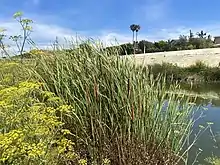
Bottlenose dolphins, harbor seals and California sea lions are occasionally spotted downstream.[47][48] In 1953, a 350-pound (160 kg) sea lion made it 3.5 miles (5.6 km) upstream before it got bogged down; the lost pinniped was lassoed by rescuers and returned to the Pacific.[49]
History

An alternative historic Spanish-language place name for the creek reported in the GNIS is Sanjón de Agua con Alisos, which roughly translates to “water ditch with sycamores.”[50] (Aliso is the North American Spanish language word for Platanus racemosa, or Western sycamore, a landmark water-loving, river-bank tree species native to the area.[51] Watercourses or irrigation channels called zanja, zanjón or sanjon are noted throughout southern California and the American Southwest generally.)[52]
A reported Tongva-language (Takic subgroup of Uto-Aztecan) placename for the Ballona estuary and wetlands was Pwinukipar, meaning “it is filled with water.”[53]
Ballona Creek was a picturesque natural waterway fed by runoff. The creek collected the water from ciénegas and the rains. Its banks were lined with sycamores, willows, tules, and other trees. This natural bounty attracted the earliest known human inhabitants of the region, the Gabrieliño-Tongva Indians, the indigenous people of the Los Angeles region.[54] For at least 3,000 years, the pre-Contact Tongva lived in the area encompassing the Ballona Creek floodplain and the Westchester Bluffs.[55][56] These indigenous peoples left a large burial ground near the region along the southwest corner of the Ballona Wetlands near the village of Guashna, alternatively spelled Washna.[56] The records of the San Gabriel Mission record recruitment of Tongva from a group of settlements named Washna (also referred to in some historical and scholarly sources as Saa’angna) near the mouth of Ballona Creek. Before the Spanish conquest, Washna was probably the most important Native American center for trade between the mainland and Catalina Island.[56]
The Spanish Portolá expedition camped at the headwaters of Ballona on August 3, 1769.[57]
At the time of Spanish settlement, Ballona Creek was a distributary of the Los Angeles River. However, the flood of 1825 changed the course of the Los Angeles River, and Ballona Creek became a distinct waterway.

Around 1820, a mestizo rancher named Augustine Machado claimed a 14,000-acre (57 km2) Mexican land grant that stretched from modern-day Culver City to Pico Boulevard in Santa Monica, California. Ballona Creek and Lagoon are named for the Ballona or Paseo de las Carretas ("wagon pass") land grant, dated November 27, 1839. The Machado and Talamantes families, co-grantees of the rancho, heralded from Baiona in northern Spain.[58][59]
In the 1840s, Francisco Higuera's adobe was "close enough to La Ballona Creek for Francisco's nine children to swim in the clear waters of the stream with its fine sandy bottom."[4]
From 1861 to 1862 the creek was home to an U.S. Army staging ground. Several soldiers posted to Camp Latham described the local vistas:
In October 1861 a Camp Latham soldier wrote the Daily Alta California expressing a desire for newspapers, and for good horses from Los Angeles (they currently had none), and provided this description of the site:[60]
The camp is situated about nine miles eastward of Los Angeles, near a stream of good water and on level ground, but to the south and north at a distance of a half mile, or less, is a range of low hills, from which a hostile battery could sweep the whole command.
Sgt. Owen of the San Jose Volunteers wrote his mother, "Camp Latham is a fine spot, seven miles from Los Angeles, bounded by high, rough old mountains on the North—hills, and a perfect love of a brook to the South—sea on the West, and on the East, hills and forests."[61]
On January 6, 1862 a "Letter from Camp Latham," dated to December 30, 1861, was published in the Sacramento Daily Union. The writer described the conditions of the camp:[62]
In May 1862 the Trinity Journal published this account from "Charley," Company H, 4th California Infantry Regiment:[63]For the past week it has rained nearly the whole time, and our parade ground is nearly floating, as we are encamped in a low valley. We are in tents without floors and without fire, so that it is no easy matter for us to keep dry, or rather, we are unable to do it, our beds and clothing being damp, and in many instances mildewed. The health of the men is very good, and if we are serving the great cause of "our country" by being here, we are content. _____________ Soldier.
The next afternoon we sailed into the harbor of San Pedro, and were taken to the landing by a light draught steamer. San Pedro is a one-horse town, with a store, blacksmith shop and two or three third-class boarding houses, for the accommodation of those who are so unfortunate as to arrive hungry. The beef in this section is the finest I have ever seen, anywhere. We remained at San Pedro one night, making our beds in alkali dust six inches deep. At 10 o'clock next morning we filled our canteens and haversacks, and started for Camp Latham, twenty miles distant. This is the finest country I have ever seen, without exception.— We traveled through a rich grazing country the whole distance, which, however, is equally valuable for farming purposes. The clover known with you as "Alfalfa," is knee high the whole distance, We passed but two fields of grain, which would equal, if not excel, any I had ever seen. For the whole distance there is not a drop of good water—but little of any kind—and but one human habitation op the road. The lands are in the hands of monopolists, and years will expire before they will be properly cultivated, the owners in many cases, being Spanish or Mexican, of whose indolence you are well aware. After a walk of seven hours the main body of the detachment reached Camp Latham, and no one who has ever been here can deny but that it is the finest-situated camp and drill ground in the State. The camp is situated on an eminence, one hundred yards from which flows a beautiful stream of sparkling water, about the size of main Weaver Creek, lined with a dense grove of sycamores, and in the immediate vicinity of camp is a pretty grove of willows, planted tastefully by an old Spaniard, and which is beginning to form a pleasant retreat for the inhabitants of the neighborhood, and the troops at this point.
In 1886, a California state report described Ballona and Centinela creeks:
- Out from the central springs of the upper belt—on ranchos La Brea and Rodeo de las Aguas—Ballona gathers its upper perennial waters, leads them south against the base of the Centinela hills. Here, reinforced by a little stream from the east, draining the springs of the ranchos La Cienega and Paso de la Tejera, it turns west and southwest, parallel with the hill’s footing, into the Ballona flats and the sea five to six miles away.[64]
Circa 1890, the renowned Machado ranch stables were located "a few hundred feet across the Ballona bridge on Overland Avenue."[26]
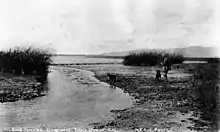
A 1912 advertisement for homes in the “Washington Park subdivision” along the creek said, “Ballona Creek is a swift-running little stream, fed by springs, and carrying plenty of water all the year. It divides in Washington Park, making a picturesque little island.”[65] In addition to other festivities organized by real-estate brokers to drum sales in the new development, “A free luncheon with hot coffee was served on Ballona Island, the wooded island in Ballona Creek.”[66]
The ranch land along the creek was put into agricultural use alongside new small towns such as Venice (est. 1905) and Culver City (est. 1917). In 1928, one writer observed, “Gradually Rancho La Ballona began to develop and people began to build. The ranches were subdivided until Rancho la Ballona became a rich valley of beautiful homes with people coming from every State until it reaches the portions of today.”[26]
Photos of a flooded Jefferson Boulevard appeared in the newspaper after a major storm in December 1931; authorities told reporters that Ballona Creek’s peak flow “more than 7000 second feet” went through the channel.[67] Deadly floods in 1934 led officials to temporarily close “small wooden bridges spanning Ballona Creek” to limit potential danger to civilians. The crossings were at Burnside Avenue, Redondo Boulevard, Thurman Avenue and Venice Boulevard.[27]
Much of the above-ground section of the creek was lined with concrete as part of the flood-control project undertaken by the United States Army Corps of Engineers between 1935 and 1939.[68][69][9]
- In 1931, the Los Angeles County Flood Control District had proposed permanent improvement of the Ballona Channel and included it in its county-wide flood control program. ¶ Subsequently, under the direction of Engineer C.H. Howell, a plan for La Ballona’s improvement was submitted to the federal government. ¶ Major Theodore Wyman Jr. sent his hundreds of workers to straighten and widen the crooked channel that since prehistoric times had been unable to hold the flood waters of rainy seasons that created lagoons and created vast swamp areas. ¶ They not only straightened, widened and deepened the meandering river, they put it in slope-sided, rock-lined strait-jacket. Also they built three bridges, with the aid of a federal grant of $800,000. ¶ The result has been increased flood protection to a wide area and the reclaiming of swamp land. In addition there has been created an estuary, formed by the flow of ocean tides, extending two miles inland from the channel mouth.[4]
Two laborers, Tony Rizzo, a 44-year-old father of six, and Barney Porres, 24, were killed by a mudslide in the channel in 1937. Two other men were injured. A coroner’s jury found that “lack of proper precautions” by flood-control management team were to blame.[70]
A contract was awarded in 1946 to extend the stone jetties an additional 550 feet (170 m) “to deflect ocean currents to prevent beach erosion.”[71]
The tributaries were channelized in the 1950s.[9] Centinela Creek’s course was set in parallel to the route of Interstate 405 and the then-forthcoming Marina Freeway. The channelization of the creek is part of the larger human reorganization of southern California hydrology, “some of the oldest and most extensive water redistribution projects in the United States.”[9]
When the Baldwin Hills Dam broke 1963, the Ballona Creek Channel carried the flood of water and debris safely to the sea.

Recreation

The Ballona Creek Bike Path, which extends almost 7 mi (11 km) from National Boulevard in Culver City to Marina Del Rey, is a popular fitness track.
More than 30 species of fish are present in the Ballona Del Rey harbor and Ballona estuary.[48] The Ballona Wetlands Land Trust offers a free, full-color, online booklet “A Guide to Fish Found in the Lower Ballona Creek and the Ballona Wetlands.”[72] The Los Angeles Department of Beaches and Harbors permits licensed fishing at the north and south jetties; licenses can be purchased at nearby shops (West Marine, Marina Del Rey Sportfishing or Del Rey Landing).[73][74] The Ballona Creek jetty is “a good spot for kelp bass, sand bass, and mackerel.”[75]
In 1950, an upstream reservoir was being drained by Los Angeles, and “Bass and blue gill, stocked in the reservoir, ran down storm drains and into Ballona Creek.” The Culver City Chamber of Commerce and Hughes Aircraft Rod & Gun Club erected a temporary dam to trap the fish and threw a fishing contest for local kids. (No adults allowed.)[76]
In popular culture
The Little Rascals of Hal Roach’s Our Gang used Ballona Creek as a filming location for shorts like “Fish Hooky” (1933).[77][78]
In the 1997 movie Volcano, Mike Roark (Tommy Lee Jones) destroys a 20-story apartment building in a controlled demolition in order to divert a flowing river of lava into Ballona Creek and thus into the Pacific Ocean.
Gallery
 Mouth of Ballona Creek and Ballona Wetlands, between Marina Del Rey and Playa Del Rey
Mouth of Ballona Creek and Ballona Wetlands, between Marina Del Rey and Playa Del Rey Above-ground origin point in the Mid-City neighborhood
Above-ground origin point in the Mid-City neighborhood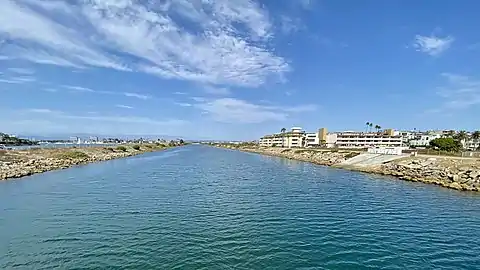 Near the mouth of the river, from Pacific Avenue Bridge
Near the mouth of the river, from Pacific Avenue Bridge Ballona Creek looking toward Playa Vista
Ballona Creek looking toward Playa Vista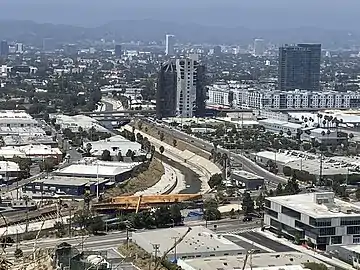 Eastern end of creek near La Cienega
Eastern end of creek near La Cienega Floating barrier on Ballona Creek
Floating barrier on Ballona Creek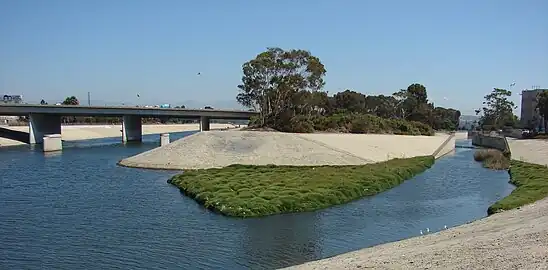 Seawater flows inland from the Pacific twice a day (at high tide) to this green salt marsh at the confluence of Ballona and Centinela Creeks
Seawater flows inland from the Pacific twice a day (at high tide) to this green salt marsh at the confluence of Ballona and Centinela Creeks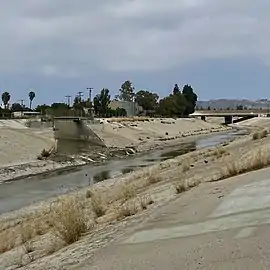 Tributary Sepulveda Creek enters Ballona; 405 freeway overpass and Baldwin Hills visible on right
Tributary Sepulveda Creek enters Ballona; 405 freeway overpass and Baldwin Hills visible on right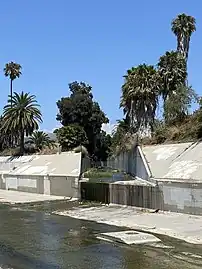 Adams Channel enters Ballona
Adams Channel enters Ballona Ballona Creek BCR 52 survey marker, United States Army Corps of Engineers
Ballona Creek BCR 52 survey marker, United States Army Corps of Engineers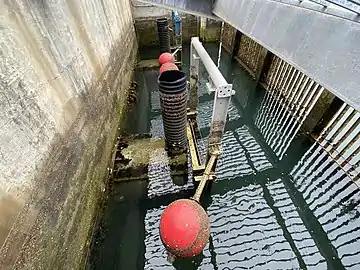 Tide gate releases water into Ballona Wetlands
Tide gate releases water into Ballona Wetlands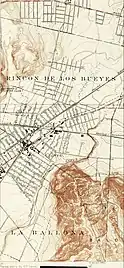 1924, still a natural stream at the base of the Baldwin Hills
1924, still a natural stream at the base of the Baldwin Hills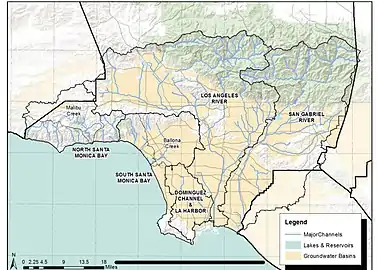 Streams and watersheds of Los Angeles County, California, including Ballona Creek
Streams and watersheds of Los Angeles County, California, including Ballona Creek Bridge construction, 1937
Bridge construction, 1937
See also
- San Gabriel River
- Santa Ana River
- Los Angeles River
- Tongva Sacred Springs
- Centinela Springs
- Brookside, Los Angeles neighborhood
- America’s National Wild and Scenic Rivers designation (Ballona Creek does not qualify at this time)
References
- 1 2 3 4 U.S. Geological Survey Geographic Names Information System: Ballona Creek
- ↑ "F.A.Q." Ballona Creek Renaissance. Archived from the original on October 17, 2021. Retrieved July 14, 2022.
- ↑ Arancibia, Juan (November 7, 1985). "Endangered Species: Urbanization Threatens Wetland Havens for Migrating Birds". Los Angeles Times. p. LWS18.
- 1 2 3 4 Robinson, W. W.; Title Guarantee and Trust Company (Los Angeles, Calif) (1939). Culver City: a calendar of events in which is included, also, the story of Palms and Playa Del Rey together with Rancho La Ballona and Rancho Rincon de los Bueyes. Los Angeles: Title Guarantee and Trust Co. Archived from the original on July 29, 2022. Retrieved July 29, 2022.
- 1 2 3 EIP Associates (2004). Ballona Creek Watershed Management Plan (Report). Archived from the original on August 7, 2016. Retrieved August 5, 2016.
- ↑ Village at Playa Vista: Volume III (PDF). City of Los Angeles. 2009. pp. 21–24.
- ↑ "Ballona Discovery Park". Friends of Ballona Wetlands. Retrieved December 26, 2022.
- ↑ "Santa Cruz Sentinel 6 June 1982 — California Digital Newspaper Collection". cdnc.ucr.edu. Archived from the original on July 29, 2022. Retrieved July 29, 2022.
- 1 2 3 4 5 6 7 8 Liu, Shu-wen (Sharon); Hogue, Terri; Stein, Eric; Barco, Janet (December 1, 2011). "Contemporary and Historical Hydrologic Analysis of the Ballona Creek Watershed" (PDF). santamonicabay.org. Archived (PDF) from the original on September 14, 2022. Retrieved July 18, 2022.
- ↑ "Hydrologic Records (NEAR REAL-TIME PRECIPITATION MAP)". L.A. County Dept. of Public Works. Retrieved January 11, 2023.
- ↑ Landry, James (2003). "Ballona Creek Trail and Bikeway Environmental and Recreational Enhancement Study" (PDF). Baldwin Hills Conservancy. Archived (PDF) from the original on April 20, 2020. Retrieved July 10, 2022.
- ↑ Ballona Watershed Management Task Force. "3". Ballona Watershed Management Plan (PDF). LA County Watershed Management Plan. p. 55. Archived (PDF) from the original on January 19, 2022. Retrieved July 13, 2022.
- ↑ Dukesherer, David J. (2010). LAX California : an early history of the region : Westchester, Playa Vista, Inglewood & Playa del Rey, (and environs). Charleston, South Carolina: Cental Historical Group Publishers. p. 68. ISBN 9781453772867. OCLC 695155443.
- ↑ "National Bridge Inventory Database". Archived from the original on October 31, 2013. Retrieved August 7, 2009.
- 1 2 3 4 5 6 7 "Ballona Creek Channel - Los Angeles CA". Living New Deal. Retrieved December 12, 2022.
- 1 2 "Ballona Creek bridge construction photo gallery - See historic photo at bottom". friends4expo.org. August 22, 2011. Archived from the original on July 19, 2022. Retrieved July 18, 2022.
- ↑ Linton, Joe (July 11, 2023). "Eyes on the Street: Culver City's New Higuera Street Bridge - Streetsblog Los Angeles". la.streetsblog.org. Retrieved October 2, 2023.
- ↑ "Higuera Street Bridge Replacement Project". www.culvercity.org. Retrieved November 8, 2023.
- ↑ "San Bernardino Sun 15 January 1928 — California Digital Newspaper Collection". cdnc.ucr.edu. Archived from the original on July 29, 2022. Retrieved July 29, 2022.
- ↑ Culver City Historical Society (Summer 2004). "New Ballona Creek Pedestrian Bridge" (PDF). Culver Historical Highlights. 25 (3): 5. Archived (PDF) from the original on October 1, 2020. Retrieved July 19, 2022.
- ↑ "The Inglewood Branch - Abandoned Rails". www.abandonedrails.com. Retrieved September 26, 2022.
- ↑ "Alla to Redondo Beach, CA - Abandoned Rails". www.abandonedrails.com. Retrieved September 26, 2022.
- ↑ Veysey, Laurence R. (1958). A HISTORY OF THE RAIL PASSENGER SERVICE OPERATED BY THE PACIFIC ELECTRIC RAILWAY (PDF). Los Angeles, California: Interurbans. pp. 55–56.
- ↑ "Report - HPLA". historicplacesla.org. Archived from the original on September 14, 2022. Retrieved August 17, 2022.
- ↑ Ferderber, Skip, Allan, Robert J. “BEACHFRONT PATH POPULAR: Bikes Take to the Seacoast,” Los Angeles Times, 1974-04-25, p. WS1.
- 1 2 3 Guzman, N.S. (March 4, 1928). "RANCHO DAYS OF PAST RECALLED: Culver City Neighborhood Pioneers' Playground, Excursions to Santa Monica Popular in 1876, Historic Fifty-Mile Horse Race Retold". Los Angeles Times. pp. B5.
- 1 2 “Torrential Rains Leave Seven Dead; $150,000 Damage: One Missing and Girl Fights for Life; Hundreds Abandon Homes and New Arroyo Floods Feared,” Los Angeles Times, 1934-10-19, p. 1.
- ↑ “Touring Information,” San Pedro Daily News, Volume XXV, Number 293, 14 January 1928, page 7.
- ↑ "Map of the Los Angeles-Pacific R.R". www.oac.cdlib.org. Retrieved September 29, 2022.
- ↑ Pitt, Leonard; Pitt, Dale (1997). Los Angeles A to Z: An Encyclopedia of the City and County. Berkeley, Calif.: University of California Press. pp. 36, 50–51. ISBN 0-520-20274-0.
- ↑ Ballona Creek Wetlands EPA Report (PDF) (Report). Los Angeles Regional Water Quality Control Board. Archived (PDF) from the original on January 19, 2022. Retrieved June 13, 2022.
- ↑ “Californians Comb Beaches in Coastal Cleanup,” California Aggie, Volume 107, Number 177, 3 October 1988, p. 6.
- ↑ "Corsair 25 September 2002 — California Digital Newspaper Collection". cdnc.ucr.edu. Archived from the original on July 30, 2022. Retrieved July 30, 2022.
- ↑ Palmer, Phillip (January 4, 2023). "LA County using Dutch nonprofit's device to keep trash out of the Pacific Ocean". ABC7 Los Angeles. Retrieved January 5, 2023.
- ↑ Castleman, Terry (May 11, 2023). "77 tons less trash made it into the ocean thanks to this experimental L.A. County device". Los Angeles Times. Retrieved May 11, 2023.
- ↑ "UPDATE: Interceptor 007 has arrived in Los Angeles, California, USA". www.twitter.com. Archived from the original on July 18, 2022. Retrieved July 18, 2022.
- ↑ "Interceptor for LA County". www.theoceancleanup.com. Archived from the original on July 26, 2022. Retrieved July 18, 2022.
- ↑ Castleman, Terry (January 20, 2023). "Ballona Creek trash interceptor damaged during storms but will be fixed soon". Los Angeles Times. Retrieved January 20, 2023.
- ↑ Engle, Jane (August 3, 2008). "Winging it on Ballona Creek; Bird-watching is splendid along the L.A. waterway". Los Angeles Times. pp. L5.
- ↑ Cannon, Kara (August 28, 2021). "Park to Playa Trail". The Book of Kara. Archived from the original on July 10, 2022. Retrieved July 10, 2022.
- ↑ "Ballona Wetlands (Ballona Valley)". Audubon. September 12, 2016. Archived from the original on February 25, 2021. Retrieved June 23, 2022.
- ↑ Lapp, Prof. Kevin D. (May 4, 2022). "Guide to Birding Ballona Creek". Always Bring Binoculars. Archived from the original on July 22, 2022. Retrieved June 24, 2022.
- ↑ Hod, Itay (August 13, 2019). "Deadly Coyote Attacks on the Rise in Culver City". Spectrum News1. Archived from the original on June 9, 2022. Retrieved June 7, 2022.
- ↑ Pridgen, Andrew (May 27, 2022). "'They're everywhere': Why California's rattlesnake population is booming". SFgate.com. Archived from the original on June 7, 2022.
- ↑ Landry, James (2003). "Ballona Creek Trail and Bikeway Environmental and Recreational Enhancement Study" (PDF). Baldwin Hills Conservancy. Archived (PDF) from the original on April 20, 2020. Retrieved July 10, 2022.
- ↑ Lapp, Prof. Kevin D. (May 23, 2022). "Birding Ballona Creek: Lincoln to Inglewood Ave". Always Bring Binoculars. Archived from the original on July 22, 2022. Retrieved July 22, 2022.
- ↑ Higgins, Lila M. (2019). Wild LA : explore the amazing nature in and around Los Angeles. Gregory B. Pauly, Jason G. Goldman, Charles Hood, Natural History Museum of Los Angeles County. Portland, Oregon. ISBN 978-1-60469-710-0. OCLC 1065819118. Archived from the original on January 8, 2022. Retrieved July 30, 2022.
{{cite book}}: CS1 maint: location missing publisher (link) - 1 2 van de Hoek, Robert Jan (September 10, 2013). "The Marine Fauna of Marina Del Rey and Ballona Creek". Marina Del Rey, CA Patch. Archived from the original on July 30, 2022. Retrieved July 30, 2022.
- ↑ "Napa Valley Register 9 November 1953 — California Digital Newspaper Collection". cdnc.ucr.edu. Archived from the original on July 30, 2022. Retrieved July 30, 2022.
- ↑ Durham, David L., California’s Geographic Names, Word Dancer Press, Clovis, Calif., 1998
- ↑ "Western Sycamore, Platanus racemosa". calscape.org. Archived from the original on August 7, 2022. Retrieved July 20, 2022.
- ↑ Field, Gail (February 17, 2016). "Do you know the way to San Jon? Ask a librarian". Ventura Breeze. Archived from the original on April 7, 2019. Retrieved July 20, 2022.
- ↑ "Inconsistencies and Missed Opportunities Ballona Wetlands Ecological Reserve". Western Tanager, Journal of the Los Angeles Audubon Society. 8 (2). October 30, 2021. Archived from the original on July 20, 2022. Retrieved July 20, 2022.
- ↑ "Short History". Ballona Creek Renaissance.
- ↑ Castillo, E. D. (1994). "Gender status decline, resistance, and accommodation among female neophytes in the missions of California: A San Gabriel case study". American Indian Culture and Research Journal. 18 (1): 67–93. Retrieved 18 August 2013. http://aisc.metapress.com/content/u861u35618852412/ Archived 2013-08-20 at archive.today
- 1 2 3 "Skeletons in Playa Vista's Closet". Los Angeles Times. June 20, 2004.
- ↑ Bolton, Herbert E. (1927). Fray Juan Crespi: Missionary Explorer on the Pacific Coast, 1769-1774. HathiTrust Digital Library. pp. 148–149. Archived from the original on July 11, 2019. Retrieved August 5, 2016.
- ↑ Erwin G. Gudde; William Bright (2004). California Place Names: The Origin and Etymology of Current Geographical Names. University of California Press. p. 25. ISBN 978-0-520-24217-3. Archived from the original on July 4, 2014. Retrieved October 4, 2011.
- ↑ "Early History". Friends of Ballona Wetlands. Archived from the original on October 2, 2011. Retrieved October 4, 2011.
- ↑ "Letter from Camp Latham, Los Angeles Co., Cal., Oct. 2d, 1861, The Army at Los Angeles—The Trouble with Colonel Davis—The Men Distrust Him". Daily Alta California. Vol. 13, no. 4252. October 10, 1861. p. 1. Retrieved March 17, 2023 – via California Digital Newspaper Collection.
- ↑ Sergeant Owen (November 19, 1861). "Column 2, no title". San Jose Daily Mercury. Vol. 1, no. 13. p. 3. Retrieved March 17, 2023 – via California Digital Newspaper Collection.
- ↑ Soldier (January 9, 1862). "Letter from Camp Latham: Correspondence of the Union". Sacramento Daily Union. Vol. 22, no. 3364. p. 2. Retrieved March 21, 2023 – via California Digital Newspaper Collection.
- ↑ Charley (May 24, 1862). "Co. H, 4th Regiment". Trinity Journal. Vol. 7, no. 19. Weaverville, California. Retrieved March 17, 2023 – via California Digital Newspaper Collection.
- ↑ Hall, W. H. (1886). Report of the State Engineer of California: On Irrigation and the Irrigation Question. Archived 2022-09-14 at the Wayback Machine United States: J. D. Young [etc.] Superintendent state printing.
- ↑ "Los Angeles Herald 28 December 1912 — California Digital Newspaper Collection". cdnc.ucr.edu. Archived from the original on July 30, 2022. Retrieved July 30, 2022.
- ↑ "Los Angeles Herald 2 November 1912 — California Digital Newspaper Collection". cdnc.ucr.edu. Archived from the original on July 30, 2022. Retrieved July 30, 2022.
- ↑ "TEN-YEARS' RAIN RECORD IN LOS ANGELES BROKEN: Flood in Long Beach Drives 1500 From Their Homes and Boats Transport School Children". Los Angeles Times. December 29, 1931. p. 1.
- ↑ Coastal Conservancy Report (PDF) (Report). July 16, 2007. p. 2. Archived (PDF) from the original on December 20, 2011. Retrieved October 4, 2011.
- ↑ "Short History". Ballona Creek Renaissance. Archived from the original on July 6, 2022. Retrieved July 6, 2022.
- ↑ "Daily News (Los Angeles) 2 March 1937 — California Digital Newspaper Collection". cdnc.ucr.edu. Archived from the original on July 30, 2022. Retrieved July 30, 2022.
- ↑ "San Pedro News Pilot 29 May 1946 — California Digital Newspaper Collection". cdnc.ucr.edu. Archived from the original on July 30, 2022. Retrieved July 30, 2022.
- ↑ "A Guide to Fish Found in the Lower Ballona Creek and the Ballona Wetlands". Ballona.org. 2020. Archived from the original on September 14, 2022. Retrieved July 30, 2022.
- ↑ "Fish Species by Location - California Fish Website". calfish.ucdavis.edu. Archived from the original on July 9, 2022. Retrieved June 23, 2022.
- ↑ "LA County Fishing – Beaches & Harbors". Archived from the original on July 30, 2022. Retrieved July 30, 2022.
- ↑ Andrew Dubbins (October 20, 2020). "As the Pandemic Continues, Angelenos Are Finding a Reprieve at the End of a Fishing Pole". Los Angeles Magazine. Archived from the original on July 30, 2022. Retrieved July 30, 2022.
- ↑ "Plenty of Fish for Youthful Anglers". San Bernardino Sun. November 25, 1950. p. 16.
- ↑ "Our Gang". www43.tok2.com. Archived from the original on September 7, 2022. Retrieved September 7, 2022.
- ↑ "Filming locations - Fish Hooky (1933)". YouTube.com. chrisbungostudios. May 1, 2020. Archived from the original on September 8, 2022. Retrieved September 7, 2022.
{{cite web}}: CS1 maint: others (link)
External links
- BALLONA CREEK HYDROLOGY (Search “Ballona Creek” for map of channels, underground storm drains and natural tributaries)
- BALLONA CREEK INFRASTRUCTURE (Survey done by Ballona Wetlands Land Trust; check all the boxes-reaches 1 thru 4-and then zoom in to view features)
- Ballona Creek and Other Urban Watersheds - excellent clear PDF format WATERSHED MAP by LA County Public Works
- Friends of Ballona Wetlands
- Ballona Creek Renaissance
- ”Birds of Ballona Creek” - 6 min YouTube video
- “A ride along the creek” - 2 min YouTube video
- Ballona Creek Watershed Management Plan of Los Angeles County (224-pg report, illustrated)
- Ballona Creek Revitalization Project - Culver City, includes 20 years of official reports about creek
- Historic Ecology of the Ballona Creek Watershed (81-pg report, illustrated)
- Ballona Creek Watershed Total Maximum Daily Loads
- Always Bring Binoculars - Guide to Birding Ballona Creek (4-part guide)
- Ballona Wetlands and Creek photo gallery - Citizen of the Planet
- “Ballona Creek rages through Culver City” video from 2019 storm
- undercity.org Ballona Creek Watershed Drains
- LMU Center for Urban Resilience: Urban EcoLab Curriculum Material
